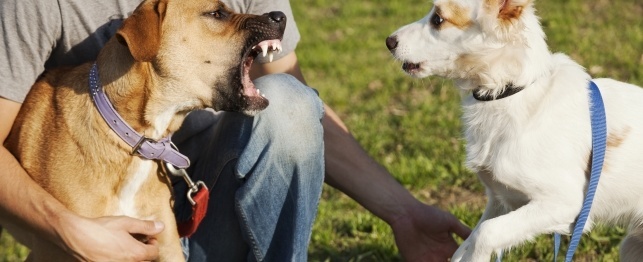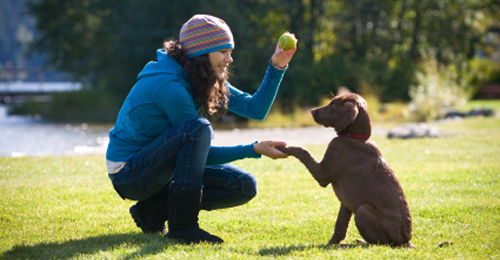Hiking with Your Dog
Dogs
Hiking with your dog can be one of the most joyful experiences of pet ownership. Besides being great exercise, it's a good way to spend quality time with your canine chum. Taking a walk in the woods is a simple thing to do, but you can maximize your enjoyment and your dog's safety by preparing ahead of time.
Before going hiking, check for any restrictions in the area. For example, national parks and some state parks do not permit dogs on hiking trails. Most parks also require your pet to be on a leash, unless you are in a designated doggie park. Leash walking is always a safer option as it decreases the chance your pet will wander into trouble. Unusual sights, sounds and smells may tempt the unleashed dog to stray deeper into the woods or bring about encounters with other animals that could cause a confrontation.
Make sure your pet is up to date on all of his vaccinations. In some areas of the country, it might be wise to vaccinate for Lyme disease as well. Your dog should also wear a collar with clear and current identification tags. Microchipping is another option that many pet owners are choosing.
Avoid areas that permit hunting. Bright colors for you, and even a bright colored collar and vest for your dog would be a good idea, in case you accidentally wander into a hunting area.
Make sure you know the limitations for you and your dog. If you are used to long hikes up tough terrain, but your dog is not, take it slow. Start with easier walks and work up to the tough ones. For smaller or older animals, certain strenuous hikes might better be skipped. For animals with arthritis or medical conditions, consulting your veterinarian first is a good idea. Even animals that are normally active might have problems on rough terrain. Pad abrasions, cuts, and ulcerations are common occurrences if your pet's pads are not adapted to walking on more abrasive surfaces. Pad protecting "booties" are commercially available that can help protect sensitive paws if needed for rough terrain or snow and ice.
Take rest breaks as needed and don't forget to bring food or snacks for yourself and your dog. Better than sharing your sandwich, bring along a dog treat or a meal specifically for your dog. Water is also important. Ideally, dogs should not drink from the ponds or small streams along the trail, for the same reasons people should not. Poor sanitation, and increasing development has led to increased incidence of contracting diseases. Giardia cysts occur in dogs and people, and can cause significant gastrointestinal distress and diarrhea. Practically speaking, it may be impossible to prevent your dog from drinking some water on the trail, but being prepared and taking some precautions will decrease the chance of illness. Some dogs may be large and strong enough to even carry their own rations, and many different types of "dog backpacks" are available for purchase. A dog with his own backpack adds another dimension of fun on the trail.
It is always a good idea to pack some emergency supplies for both you and your pet. A small first aid kit for dogs should contain a few important items. Bandage materials, tape and a disinfectant (e.g. hydrogen peroxide) are included for cleaning and wrapping wounds. Antibiotic (e.g. Neosporin®) and cortisone creams are useful for cuts and insect bites respectively. Diphenhydramine (check with your veterinarian for a dosage for your dog) is useful for severe reactions to insect stings or hypersensitivities. Consider taking an anti-inflammatory, like aspirin, for use after a long days' hike. Just like people, after a long day hiking, many dogs may be sore the next day. Anti-inflammatories will help with a quicker recovery. Check with your veterinarian for the right dose and best anti-inflammatory for your pet. In certain areas of the country a snakebite kit is also a good item to have handy. For more information on first aid for your dog, see First Aid: The Top 10 Things You Need To Know.
Be considerate to others on the trail by keeping the environment clean, and leaving it the way you found it. If your dog messes on the trail, clean it up and pack it out. This is the best way to ensure the continued availability of hiking trails to you and your dog. If this is not possible, at the very least, make sure the stool is moved away from the trail.
In most areas of the country, it is advisable that your dog be on heartworm preventative medication, especially when hiking in mosquito-infested woods. Insect repellents that are safe for pets are also available and may be very useful at certain times of the year. It is also a good idea for dogs to be on a flea and tick preventative when out in the woods. Fleas may cause skin problems and allergies, and ticks may cause infections and spread disease. Prevention using the many products available through your veterinarian is the best defense.
Taking the time to do a little planning ahead will ensure a happier and more fulfilling hiking experience.

 Dog Parks and Bites: What You Need to Know
Dog Parks and Bites: What You Need to Know
Dog Parks and Bites: What You Need to Know
Dog Parks and Bites: What You Need to Know
 Dog Games - Try Puppy Push-Ups
Dog Games - Try Puppy Push-Ups
Dog Games - Try Puppy Push-Ups
Dog Games - Try Puppy Push-Ups
 Secrets To German Shepherd Coaching
Keep the courses sessions short but often. When things lose
Secrets To German Shepherd Coaching
Keep the courses sessions short but often. When things lose
 Tips for Keeping Your Dog Safe at the Dog Park
Tips for Keeping Your Dog Safe at the Dog Par
Tips for Keeping Your Dog Safe at the Dog Park
Tips for Keeping Your Dog Safe at the Dog Par
 Commercial Brain Games Challenge Your Dog
Commercial Brain Games Challenge Your Dog
Commercial Brain Games Challenge Your Dog
Commercial Brain Games Challenge Your Dog